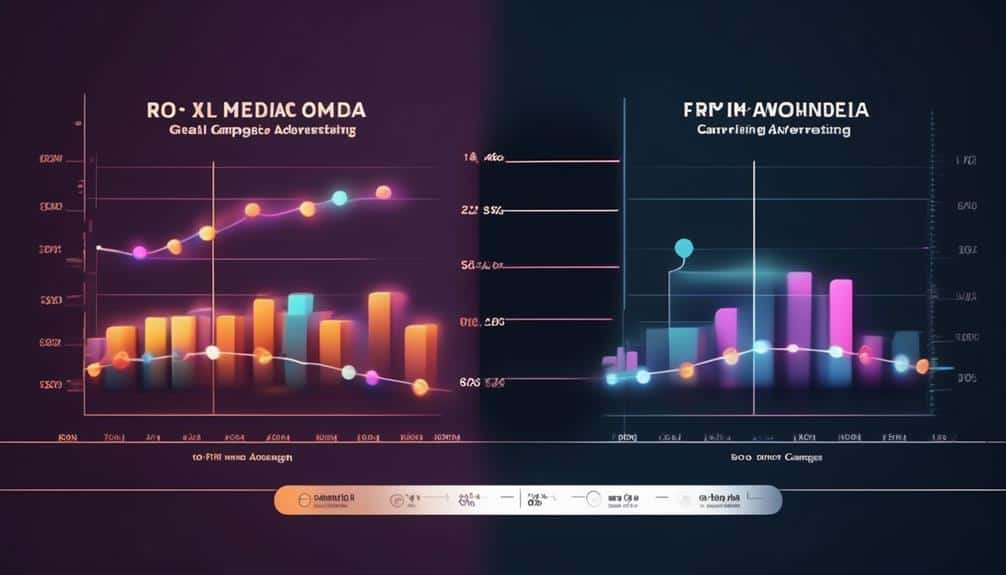Measuring Impact: Analyzing Your Social Media Advertising ROI
Measuring the impact of your social media advertising ROI is crucial for the success of your campaigns. Have you ever wondered just how effective your social media ads truly are?
The numbers behind your campaigns hold the key to unlocking valuable insights that can shape your future strategies and drive tangible results for your business. Understanding the intricate process of analyzing your ROI is not only a skill but a necessity in today's digital landscape.
By unraveling the mysteries behind the metrics, you can make informed decisions that propel your brand forward in the competitive realm of social media advertising.
Key Takeaways
- Social media advertising ROI is crucial for optimizing marketing strategies and maximizing returns.
- Data-driven decisions are empowered through analyzing key metrics and performance tracking metrics.
- Click-through rates and conversion rates are essential in evaluating ad performance and determining ROI.
- Customer acquisition and return on ad spend are vital metrics for assessing campaign profitability and business growth.
Importance of Social Media Advertising ROI

Understanding the importance of Social Media Advertising ROI is crucial for businesses aiming to optimize their marketing strategies and maximize returns. When it comes to tracking effectiveness, Social Media Advertising ROI provides a clear picture of how well your campaigns are performing. By measuring success through metrics such as click-through rates, conversions, and engagement levels, you can make data-driven decisions to enhance your overall marketing efforts.
Analyzing Social Media Advertising ROI enables you to allocate your resources effectively. By identifying which campaigns are generating the highest returns, you can optimize your budget allocation for future initiatives. This data-driven approach allows you to focus on strategies that have proven to be successful, ultimately increasing your overall ROI.
Moreover, understanding Social Media Advertising ROI empowers you to stay ahead of the competition. By continuously monitoring and evaluating the performance of your campaigns, you can adapt quickly to market trends and consumer behaviors. This agility is essential for sustaining long-term success in the dynamic landscape of social media marketing.
Key Metrics to Track
To effectively measure the success of your social media advertising campaigns, it is essential to track key metrics that provide valuable insights into their performance. Two crucial metrics to focus on are engagement rates and conversion tracking. Engagement rates indicate how well your audience is interacting with your content, showing the level of interest and connection your ads are creating. On the other hand, conversion tracking measures the actions users take after viewing your ads, whether it's making a purchase, signing up for a newsletter, or downloading a resource.
Consider the following table that highlights the importance of tracking these metrics:
| Metric | Importance | Actionable Insights |
|---|---|---|
| Engagement Rates | Measure interest | Refine content strategy |
| Conversion Tracking | Track effectiveness | Optimize ad performance |
Tools for Analysis

When analyzing social media advertising ROI, you should focus on:
- Data visualization options
- Performance tracking metrics
- Reporting frequency choices
Utilizing these tools can help you gain insights into the effectiveness of your campaigns, track key metrics accurately, and make data-driven decisions for your social media advertising strategy.
Data Visualization Options
Using the right data visualization tools is crucial for effectively analyzing social media advertising ROI. When considering graphical representation of engagement rates, tools like interactive dashboards and heat maps can provide a clear overview. For tracking conversion rates, data visualization tools such as funnel charts and cohort analysis are beneficial. These tools offer insights into customer behavior and help optimize advertising strategies. Below is a table showcasing different data visualization options for analyzing social media advertising ROI:
| Graphical Representation | Engagement Rates | Data Visualization | Conversion Rates |
|---|---|---|---|
| Interactive Dashboards | Heat Maps | Funnel Charts | Cohort Analysis |
| Data Reports | Social Listening | A/B Testing | Conversion Funnel |
| Data Visualizations | Click-Through Rates | Customer Segmentation | ROI Analysis |
Performance Tracking Metrics
Effective analysis of social media advertising ROI relies on utilizing performance tracking metrics, which are essential tools for optimizing advertising strategies and gaining insights into customer behavior. To measure the impact of your social media campaigns effectively, consider the following key metrics:
- Engagement Rates: Monitor how users interact with your content to gauge the level of audience involvement and interest.
- Conversion Rates: Track the percentage of users who take a desired action after engaging with your ads, providing valuable insights into campaign effectiveness.
- Click-Through and Bounce Rates: Analyze the number of users who click on your ads and subsequently navigate away from your site without interacting further, helping you refine targeting and content strategies for better results.
Reporting Frequency Choices
To determine the ideal reporting frequency for analyzing social media advertising ROI, consider the available tools for in-depth data analysis and insights. Frequency analysis plays a crucial role in monitoring the performance of your social media advertising campaigns.
By selecting the right reporting frequency, you can stay updated on key metrics and make informed decisions promptly. Whether you opt for daily, weekly, or monthly reports, each choice impacts your ability to spot trends effectively. Regular reporting allows for trend spotting, enabling you to identify patterns, anomalies, and opportunities in real-time.
Leveraging advanced analytics tools can streamline this process, providing you with the necessary data to optimize your social media advertising strategy for maximum ROI.
Strategies for Optimization

Utilize data-driven decision-making to optimize your social media advertising ROI.
Continuously monitor performance metrics to identify trends and areas for improvement.
Implement strategic adjustments based on insights to enhance the effectiveness of your campaigns.
Data-Driven Decision-Making
Employing a data-driven approach is essential for optimizing social media advertising ROI. To make informed decisions and enhance your campaigns, consider the following strategies:
- Utilize A/B testing: Test different variations of your ads to determine which elements resonate best with your audience. This iterative process allows you to refine your campaigns based on real data insights.
- Leverage predictive analytics: Use historical data and predictive models to forecast trends and anticipate future outcomes. By understanding potential scenarios, you can adjust your strategies proactively for better results.
- Implement campaign optimization: Continuously monitor and analyze key performance indicators to identify areas for improvement. By optimizing your campaigns based on data-driven insights, you can maximize your advertising ROI effectively.
Continuous Performance Monitoring
Optimizing social media advertising ROI requires a continual focus on monitoring performance metrics to drive strategic campaign adjustments and maximize results. To achieve performance improvement, engaging in trend analysis is vital. By continuously monitoring key metrics such as click-through rates, conversion rates, and engagement levels, you can identify patterns and trends that indicate what is working well and what needs adjustment. Utilizing this data-driven approach allows for agile decision-making, enabling you to optimize your social media advertising strategies effectively. Below is a table illustrating how monitoring performance metrics can lead to enhanced results:
| Metrics | Importance |
|---|---|
| Click-Through Rates | High |
| Conversion Rates | Critical |
| Engagement Levels | Significant |
| Return on Ad Spend | Essential |
| Customer Acquisition | Vital |
Calculating ROI
To calculate the ROI of your social media advertising efforts, you need to divide the net profit generated by the cost of the investment and express the result as a percentage. Here are three key considerations to enhance your ROI analysis:
- ROI Formula Variations: Explore different ROI formula variations to align with your specific objectives. For instance, incorporating customer lifetime value into the calculation can provide a more comprehensive view of your returns.
- Industry Benchmarks: Compare your ROI results against industry benchmarks to gain valuable insights into your performance. Understanding how your ROI stacks up against competitors can highlight areas for improvement and optimization.
- Attribution Modeling: Implement advanced attribution modeling techniques to accurately attribute conversions to your social media advertising efforts. This approach enables you to assign value to each touchpoint in the customer journey, leading to a more precise ROI calculation.
Case Studies and Examples

Explore real-world case studies and examples to gain practical insights into the effectiveness of social media advertising campaigns. Real-life applications provide valuable lessons that can be applied to your own strategies. Success stories from various industries showcase how innovative approaches yield positive results. By studying these examples, you can uncover industry benchmarks and best practices that drive exceptional ROI.
For instance, a clothing brand utilized influencer partnerships on Instagram, resulting in a 25% increase in online sales within a month. This case study demonstrates the power of leveraging social media influencers to reach a broader audience and drive conversions.
In another example, a tech startup ran a targeted Facebook ad campaign that led to a 40% boost in app installations. Analyzing this success story reveals the importance of precise audience targeting and compelling ad creatives.
Frequently Asked Questions
How Can Businesses Effectively Integrate Their Social Media Advertising ROI Data With Their Overall Marketing Strategy?
To effectively integrate your social media advertising ROI data with your marketing strategy, analyze metrics aligning with goals. Utilize insights to optimize campaigns, allocate resources efficiently, and refine targeting. Integrate data-driven decisions to enhance overall marketing impact.
What Are Some Common Challenges Businesses Face When Trying to Measure the Impact of Their Social Media Advertising Roi?
Facing challenges in measuring social media advertising ROI is common. Solutions include setting clear objectives, tracking relevant metrics, utilizing analytics tools, and conducting A/B testing. These strategies can enhance your ability to analyze impact effectively.
How Can Businesses Ensure That They Are Accurately Tracking and Attributing Conversions to Their Social Media Advertising Efforts?
Ensure accurate conversion attribution by setting up tracking pixels, utilizing UTM parameters, and integrating CRM systems. Analyze impact data to optimize campaigns effectively. Consistent monitoring and tweaking lead to improved ROI measurement and campaign success.
Are There Any Emerging Trends or Technologies That Are Changing the Way Businesses Analyze and Optimize Their Social Media Advertising Roi?
In today's digital landscape, businesses must leverage AI analytics and blockchain technology to stay ahead in optimizing social media advertising ROI. These emerging trends offer advanced data insights and secure attribution models for more efficient campaigns.
How Can Businesses Benchmark Their Social Media Advertising ROI Against Industry Standards to Gauge Their Performance?
To benchmark your social media advertising ROI against industry standards and assess performance, analyze key metrics like engagement rates, conversion rates, and customer acquisition costs. Compare these data points with industry benchmarks to identify areas for improvement.
Conclusion
In conclusion, measuring your social media advertising ROI is crucial for understanding the effectiveness of your campaigns. By tracking key metrics, utilizing tools for analysis, and implementing optimization strategies, you can ensure that your advertising efforts are generating a positive return on investment.
Calculating ROI accurately will allow you to make informed decisions and allocate resources effectively. Stay focused on analyzing the data to drive meaningful results and maximize the impact of your social media advertising efforts.








